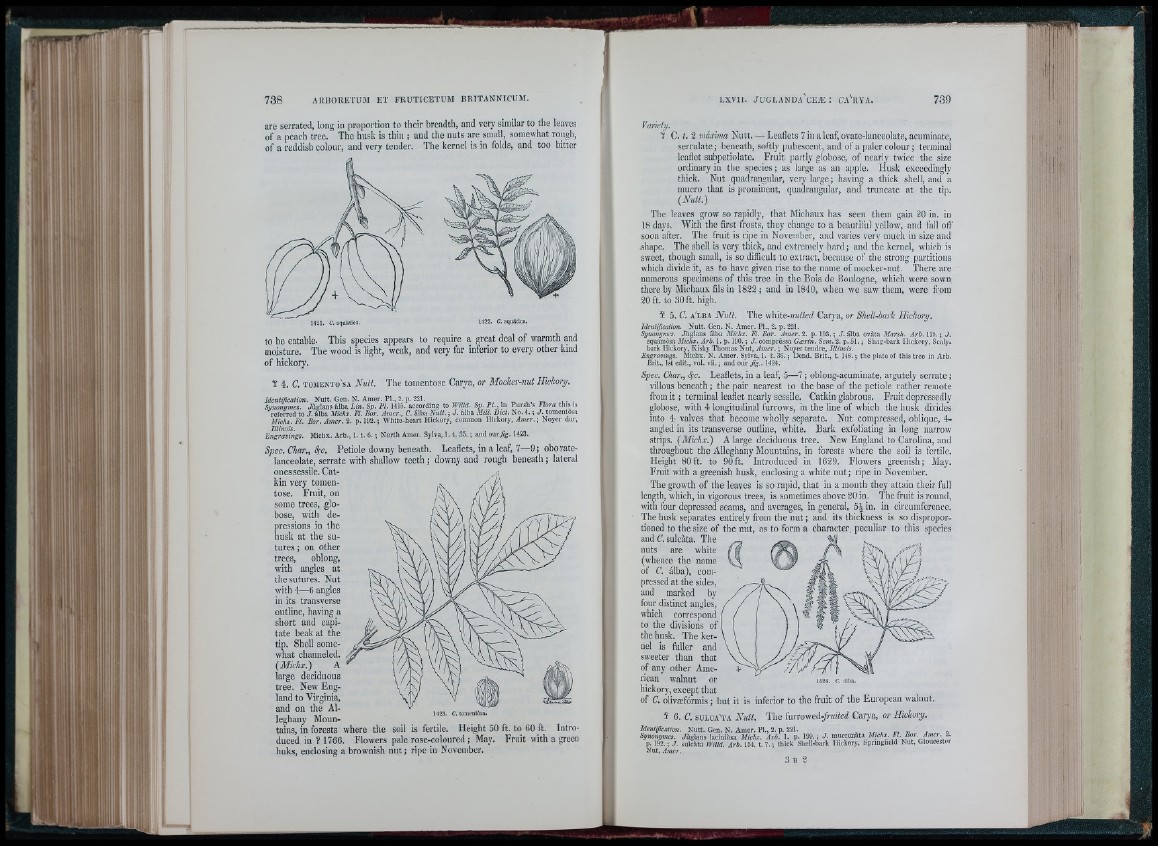
are serrated, long in proportion to their hrcadth, and very similar to the leaves
of a peach tree. The husk is thin ; and the nuts are small, somewhat rough,
of a reddish colour, and very tender. The kernel is in (bids, and too bitter
14-21. C. aquatica. 1122. C. aquàtica.
to be eatable. This species appears to require a great deal of warmth and
moisture. The wood is light, weak, and very far inferior to every other kind
of hickory,
i 4. C. TOMENTO'SA N u tl. The tomentose Carya, or Mocker-nut Hickm-y.
Identification. Nutt. Gen. N. Amer. Pl., 2. p. 221. „ . r., •
Synonymes. Jùglans èlba L in . Sp. Pl. 1415. according to Wtlld. Sp. P l., m Pursh’s Flora this is
referred to J . àlba Mickx. FL Bor. Amer., C. àlba Nutt, j J . àlba Mill. Diet. No. 4. ; J . tomentósa
Miclix. Fl. Bor. Amer. 2. p. 192. ; White-heart Hickory, common Hickory, Amer. ; Noyer dur,
Engravings. Michx. Arb., 1. t. G. ; North Amer. Sylva, 1. t. 35. ; and o u r ^ . 1423.
Spec. Char., 4c. Petiole downy beneath. Leaflets, in a leaf, 7—9; oboyate-
lanceolate, serrate with shallow teeth ; downy and rough beneath ; lateral
ones sessile. Catkin
very tomentose.
Fruit, on
some trees, globose,
with depressions
in the
husk at the sutures
; on other
trees, oblong,
with angles at
the sutures. Nut
with 4—6 angles
in its transverse
outline, having a
short and capitate
beak at the
tip. Shell somewhat
channeled.
{M ich x.) A
large deciduous
tree. New England
to Virginia,
and on the Alleghany
Mountains,
1423. C. tomentosa.
in forests where the soil is fertile. Height 50 ft. to 60 ft. Introduced
in ? 1766. Flowers pale rose-coloured ; May. Fruit with a green
huks, enclosing a brownish nut ; ripe in November.
Variety.
¥ C. Í. 2 maxima Nutt. — Leaflets 7 in a leaf, ovate-lanceolate, acuminate,
serrulate ; beneath, softly pubescent, and of a paler colour ; terminal
leaflet subpetiolate. Fruit partly globose, of nearly twice the size
ordinary in tiie species ; as large as an apple. lîusk exceedingly
thick. Nut quadrangular, very large; having a thick shell, and a
mucro that is prominent, quadrangular, and truncate at the tin.
(Nutt.)
The leaves grow so rapidly, that Michaux has seen them gain 20 in. in
18 days. With the first frosts, tlicy change to a beautiful yellow, and fall off
soon after. The fruit is ripe in November, and varies very much in size and
shape. The shell is very thick, and extremely hard; and the kernel, wiiich is
sweet, though small, is so difficult to extract, because of the strong partitions
which divide it, as to have given rise to the name of mocker-nut. There are
numerous specimens of this tree in the Bois de Boulogne, which were sown
there by Michaux fils in 1822 ; and in 1840, when we saw them, were from
20 ft. to 30 ft. high.
¥ 5. C. A'LBA Nutt. The white-nuUed Carya, or Shell-bark Hickory.
Identification. Nutt. Gen. N. Amer. Pl., 2. p. 221.
Synonymes. Jùglans álba Michx. Fl. Bor. Amer. 2. p. 193. ; J . álba ovàta Marsh. Arb. 115. ; J.
squamósa Michx. Arb. 1. p. 190. ; J . comprèssa Gærtn. Sem. 2. p. 51. ; Shag-bark Hickory, Scaly,
bark Hickory, Kisky Thomas Nut, Amer. ; Noyer tendre, Illinois.
Engravings. Michx. N. Amer. Sylva, 1. t. 36. ; Dend. Brit., t. 148. ; the plate of this tree in Arb.
Brit., 1st edit., vol. vii. ; and our fig.. 1424.
Spec. Char.y Leaflets, in a leaf, 5—7 ; oblong-acuminate, argutely serrate ;
villous beneath ; the pair nearest to the base of the petiole rather remote
from it ; terminal leaflet nearly sessile. Catkin glabrous. Fruit depressedly
globose, with 4 longitudinal furrows, in the line of which the husk divides
into 4 valves that become wholly separate. Nut compressed, oblique, 4-
angled in its transverse outline, white. Bark exfoliating in long narrow
strips. (Michx.) A large deciduous tree. New England to Carolina, and
throughout the Alleghany Mountains, in forests where the soil is fertile.
Iieight 80ft. to 90ft. Introduced in 1629. Flowers greenish; May.
Fruit with a greenish husk, enclosing a white nut; ripe in November.
The growth of the leaves is so rapid, that in a month they attain their full
length, which, in vigorous trees, is sometimes above 20 in. The fruit is round,
with four depressed seams, and averages, ingenerai, 5 |in . in circumference.
The husk separates entirely from the nut ; and its thickness is so dispropor-
tioned to the size of the nut, as to form a character, peculiar to this species
and C. sulcàta. The ^
nuts are white f ?
(whence the name
of C. álba), compressed
at the sides,
and marked by
four distinct angles,
which correspond
to the divisions of
the husk. The kernel
is fuller and
sweeter than that
of any other American
walnut or
hickory, except that
of C. olivæfôrmis ; but it is inferior to the fruit of the European walnut.
¥ 6 . C. s u l c a ' t a Nutt. The furrowed/rwM Carya, or Hickory.
Identification. Nutt. Gen. N. Amer. Pl., 2. p. 221.
Synonymes. Jùglans laciniòsa Michx. Arb. 1. p. 199.; J . uiiKTuuaLci THicronàta Michx.A-xji./.-... Fl./ Bor. Amer. 2.
—
p. 192. ; J . sulcàta Willd. Arb. 154. t. 7. ; thick Shell-bark Hickory, Sprmgheld Nut. Gloucester
Nut, Amer.